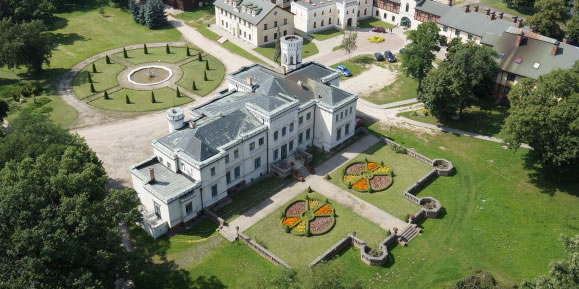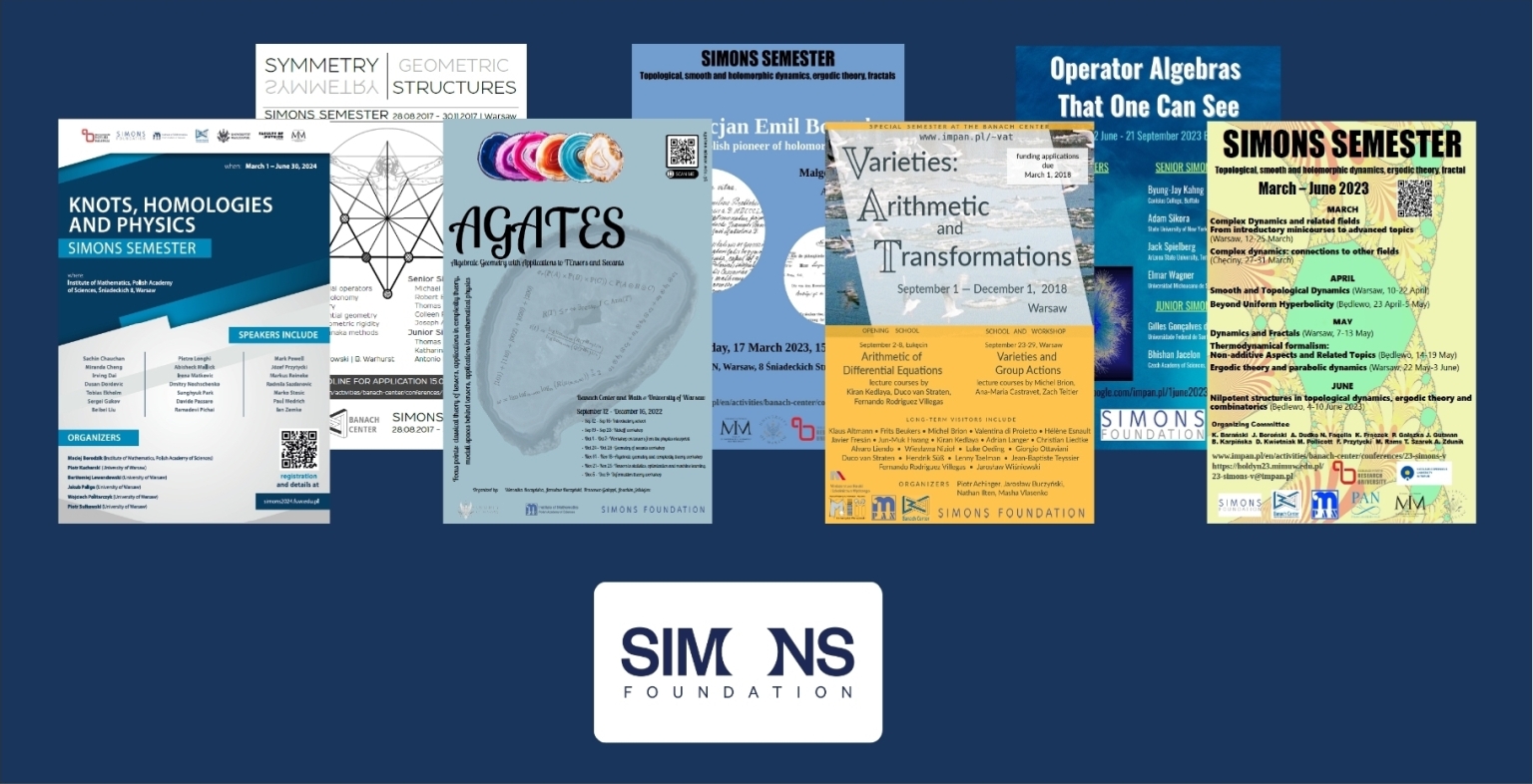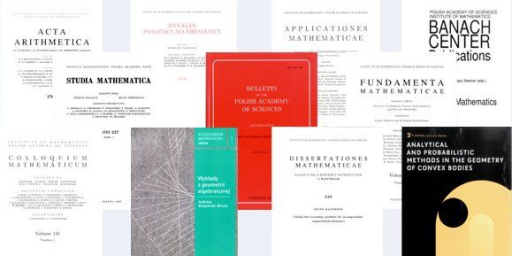Special lectures for PhD students
Special lectures for PhD students in 2015
Prelegent: Prof. Yemon Choi (Lancaster University)
April 13-16, 2015,
Topics in the (non-)amenability of Banach algebras
Special lectures for PhD students in 2015
Prelegent: Prof. David Gérard-Varet (Université Denis Diderot Paris 7, France
March 9, 2015,
The Taylor model in magnetohydrodynamics
| Day | hours | room |
|---|---|---|
| Monday, 9 | 1630-1800 | 106 IMPAN |
Abstract
We shall discuss a model introduced by J.B. Taylor in 1963, that comes from a formal asymptotic limit of MHD equations with rotation. This asymptotic model, relevant to the Earth's dynamo problem, should in principle allow for easier numerics. However, its simulation has been unsuccessful so far, due to unclear stability properties. The aim of the talk is to present recent mathematical results on this stability issue (joint works with E. Dormy, I. Gallagher, L. Saint-Raymond).
Special lectures for PhD students in 2015
Prelegent: Prof. David Gérard-Varet (Université Denis Diderot Paris 7, France
March 10 - 13, 2015
Mathematical analysis of boundary layers in fluid mechanics
| Day | hours | room |
|---|---|---|
| Tuesday, 10 | 1630-1800 | 321 IMPAN |
| Wednesday, 11 | 1000-1130 | 321 IMPAN |
| Thursday, 12 | 1000-1130 | 403 IMPAN |
| Friday, 13 | 1000-1130 | 321 IMPAN |
Abstract
In a fluid flow of high velocity, or small viscosity, one can observe strong velocity gradients near the solid boundary surrounding the flow. The thin region near the boundary where this phenomenon takes place is called a boundary layer. Mathematically, it corresponds to a singular limit of the Navier-Stokes equation, in which a parameter called Reynolds number is sent to infinity. This generates various mathematical problems : derivation of a reduced system describing the boundary layer, well-posedness of this system, rigorous justification of the boundary layer asymptotics. The lectures will present some recent developments on these topics, and the underlying mathematical tools. Outline for the lectures .
Lecture 1:
- D'Alembert's paradox.
- Inviscid limit of the Navier-Stokes equation.
- The boundary layer phenomenon : Kato's theorem.
Lecture 2:
- The Prandtl model for the boundary layer.
- Positive results on the Prandtl model : Oleinik's result for monotonic data, Sammartino and Caflisch result for analytic data.
- Grenier's instability theorem for the Prandtl boundary layer expansion.
Lecture 3:
Ill-posedness of the Prandtl equation in Sobolev spaces.
Lecture 4:
Boundary layers for rotating fluids
Special lectures for PhD students in 2015
Prelegent: Dr Damian Osajda (Instytut Matematyczny PAN i Uniwersytet Wrocławski)
March 10 - 13, 2015
Embedding infinite graphs into finitely generated groups
| Day | hours | room |
|---|---|---|
| Wednesday, 11 | 1500-1630 | 321 IMPAN |
| Thursday, 12 | 1500-1630 | 106 IMPAN |
| Friday, 13 | 1015-1130 | 106 IMPAN |
Download script
Summary
The aim of this course is to explain the recent construction [Osa14] of finitely generated groups whose Cayley graphs contain isometrically some infinite sequences of finite graphs. For expanding sequences the resulting groups are not coarsely embeddable into Hilbert spaces and are counterexamples to the Baum-Connes conjecture with coeficients. The only other groups with those features are Gromov monsters [Gro03] - groups into which expanders embed weakly. For other families of graphs the technique allows to construct first examples of finitely generated groups with some exotic properties, e.g. a-T-menable groups without Yu's property A. The course will cover (hopefully, roughly, and up to some shifts) the following subjects: .
Day 1. Formulation of the main goal, some motivations, and generalities on the approach. Basics of graphical small cancellation theory: definitions, examples, main properties (e.g. isometric embedding of relators). Some history, including a short discussion of Gromov's method [Gro03].
Day 2. A fairly detailed presentation of the proof of the main theorem from [Osa14] - embedding isometrically an infinite sequence of graphs into a finitely generated group. Applications to specific families of graphs. Finitely generated groups containing expanders. Further applications and remarks.
Day 3. Yu's property A and coarse embeddability into a Hilbert space. The construction of groups without property A acting properly on CAT(0) cubical complexes: Small cancellation labellings of graphs with walls, and defining a proper lacunary walling for such groups. Final remarks.
References
[Gro03] M. Gromov, Random walk in random groups, Geom. Funct. Anal. 13 (2003), no. 1, 73-146.
[Osa14] D. Osajda, Small cancellation labellings of some infinite graphs and applications (2014), preprint, available at arXiv:1406.5015.
Special lectures for PhD students in 2014
Prelegent Prof. Andrzej Żuk (Institut de Mathématiques, Université Paris 7)
December 15 - 19, 2014,
ANALIZA I GEOMETRIA NA GRUPACH
| Day | hours | room |
|---|---|---|
| Monday, 15 | 1400-1530 1545-1630 |
403 IMPAN |
| Tuesday, 16 | 1500-1630 | 321 IMPAN |
| Wednesday, 17 | 1400-1530 1545-1715 |
321 IMAPN |
| Thursday, 18 | 1400-1530 1545-1715 |
321 IMPAN |
| Friday, 19 | 1400-1530 | 321 IMPAN |
Skrypt
Abstract
Tematem wykładów będą następujące klasyczne zagadnienia w teorii grup:
- Problem Burnsida: skończenie generowane, ale nieskończone grupy ze wszystkimi elementami skończonego rzędu;
- Problem Milnora: grupy o wzroście szybszym od wielomianowego, ale wolniejszym od wykładniczego;
- Problem Daya: egzotyczne grupy ze średnią Banacha
- Problem Atiyaha: rozmaitości z niewymiernymi liczbami Bettiego L²;
- Konstrukcja Margulisa: rodziny bardzo spójnych grafów;
- Problem Gromowa: grupy o wzroście wykładniczym, ale niejednostajnym
- Przedstawione zostaną proste rozwiązania powyższych problemów. Będzie to okazja, żeby opowiedzieć o:
- Grupach generowanych przez automaty;
- Własności (T);
- Grupach i grafach losowych;
- Niezmiennikach L² grup i rozmaitości;
- Spacerach losowych na grupach i grafach.
Special lectures for PhD students in 2014
Prelegent Prof. Michael Megrelishvili (Bar-Ilan University, Israel)
April 7-11, 2014,
Banach representations of dynamical systems
| Day | hours | room |
|---|---|---|
| Monday, 7 | 0930-1045 1100-1200 |
321 |
| Tuesday, 8 | 1500-1615 1630-1730 |
321 |
| Wednesday, 9 | 1230-1345 1445-1545 |
321 |
| Thursday, 10 | 1115-1230 1345-1445 |
321 |
| Friday, 11 | 1015-1130 1245-1245 |
321 |
Special lectures for PhD students in 2012
Michael Winkler (Universität Paderborn)
December 10-13, 2012,
Boundedness vs. blow-up in the Keller-Segel system
| Day | hours | room |
|---|---|---|
| Monday, 10 | 1015-1145 1615-1745 |
106 |
| Tuesday, 11 | 1015-1145 1515-1645 |
105 |
| Wednesday, 12 | 1015-1145 1515-1645 |
105 106 |
| Thursday, 13 | 1615-1700 | 106 |
Matthias Hieber (TU Darmstadt)
November 19-22, 2012,
Navier-Stokes problem in Lp spaces
Summary
- Lp-theory of the linear Stokes equation: Part I. The fundamental questions like Helmholtz projection on the space Lp (Ω) or Stokes semigroup on this space over various domains will be addressed.
- Lp-theory of the linear Stokes equation: Part II. The results of the first talk will be extended to the domains with noncompact boundaries. H∞ calculus will be introduced.
- Lp-theory of the Navier-Stokes equation. Classical solutions based on the Kato scheme will be constructed.
- Fluid-solid interactions: Part I. The Lp-theory of the strong solutions to the problem of immersions of the solid body in the Newtonian fluids will be considered.
- Fluid-solid interactions: Part II. The results of the previous talk will be extended to the case of the generalized Newtonian fluids.
- Geophysical flows: Part I. Solutions of rotating fluids including the Coriolis force will be constructed.
- Geophysical flows: Part II. Stability of Ekman spirals will be studied.
- Stokes equations on spaces of bounded functions.
Lars Diening (LMU Munich)
October 15-19, 2012,
Lectures on p-Laplace equation
Abstract
Lars Diening Lecture Notes
Prof. Jiři Neustupa (Charles University in Prague)
May 21-23, 2012,
Jiři Neustupa Lecture Notes
On regularity of weak solutions of the Navier-Stokes equations
Abstract:
First four lectures will deal with conditional results on regularity of Navier-Stokes system, including: Serrins criterion for the interior spatial regularity of the weak solution and its generalizations; Lerays Theoreme de Structure on the partial regularity of a weak solution, satisfying the strong energy inequality; Hausdorff dimension of the set of singular points of a suitable weak solution; regularity criteria that impose conditions only on some components of the vorticity or the gradient of velocity.
Introduction to modelling of flows around rotating bodies
Abstract:
Last two lectures are focused on flows around rotating bodies: derivation of the equations, the steady linearized problem (the associated Stokes- and Oseen-type operators, their basic properties, spectra, generated semigroups); briefly on corresponding nonsteady and nonlinear problems.
Prof. Konstantin Pileckas (Vilnus University)
The Flux Problem in the Theory of Stationary Navier-Stokes Equations
April 16-20, 2012,
Konstantin Pileckas Lecture Notes
Abstract
Special lectures for PhD students in 2011
Analytical and probabilistic methods in high-dimensional geometry
Prof. Stanisław Kwapień (University of Warsaw) Banach space valued martingales
December 16, 2011, 1500–1830
Stanisław Kwapień Lecture Notes, part 1
Abstract:
- Generalities on martingales in Banach spaces
- Connections of convergence of L1, bounded martingales in a Banach space with dentability of boundedd sets, the Radon-Nikodým and Choquet barycenter theorem property.
- Burkholder martingale inequalities and uniform convexity (smoothness) of Banach space. Pisier and Enflo theorems.
- UMD (Unconditional Martingale Diffrences) Banach spaces and boundnes of singular operators in Hilbert spaces. Bulkhorder functions.
Krzysztof Oleszkiewicz ((University of Warsaw) On the discrete cube
December 14, 2011, 1500–1800
Krzysztof Oleszkiewicz Lecture notes
Abstract:
The study of the discrete cube (and functions defined on it) is of importance in many branches of mathematics, including combinatorics, Banach space geometry, probability theory and harmonic analysis. Obviously, it has many natural applications in theoretical computer science. In a short one-day series of lectures a brief introduction to the basic motivations and methods will be given, with several simple examples to illustrate them.
Professors Dmitry Ryabogin and Artem Zvavitch (Kent State University)
Analytical methods in convex geometry (23 hours)
November 21 – 26, 2011
Lecture Notes
Abstract:
The notion of duality is a very important notions in mathematics. It is playing one of the central roles in Functional Analysis and Convex Geometry. It is hard to believe, but there are still a number of “classical” open problems tightly connected to this notion. Our main goal here is to discuss some of these problems and to present just a few of the classical and some modern analytic methods that might be useful to attack them. We will talk about Mahler's conjecture on the minimality of the product of volumes of a convex body and its polar.
We will also discuss some problem of the local characterizations of some classes of convex bodies (zonoids). Finally, we will present a number of open problems connected with the uniqueness (or non-uniqueness!) of convex bodies given by the volumes of their projections or/and sections. In particular, we will talk about recent solutions of the problems of Klee and Bonensen.
Prof. Olivier Guédon, Universite Paris-Est, Marne-la-Vallee
Concentration inequalities in the geometry of convex bodies
April 11 – 15, 2011 (15 hours)
Olivier Guédon Lecture Notes
Abstract:
The course will be devoted to the study of concentration inequalities in the geometry of convex bodies, going from the proof of Dvoretzky's theorem due to Milman until the presentation of the theorem of Paouris telling that most of the mass of an isotropic convex body is "contained" in a multiple of the Euclidean ball of radius the square root of the ambient dimension. I will try to cover most of the mathematical staff needed to understand the proof of these results. On the way, we will meet different topics of functional analysis, convex geometry and probability in Banach spaces.
We will start with some harmonic analysis, with the Brascamp-Lieb inequalities and its geometric consequences.
I will continue with Gaussian concentration inequalities and the classical proof of Dvoretzky's theorem.
After this, I will come back to some functional inequalities like Prekopa-Leindler. It is a generalization of the well-known Brunn-Minkowski inequality. Some other type of functional inequalities have nice geometric consequences (like Busemann Theorem) and we will present some of these objects.
The study of some reverse Hölder inequalities (also called Lyapounov inequalities) is very developed in the context of log-concave or s-concave functions. I will discuss classical results and the relation with geometric conjecture like the hyperplane conjecture.
I will finish with the presentation of the proof of the result of Paouris. We will need most of the tools introduced during the previous lectures. The Dvoretzky theorem, the notion of Zp bodies and the reverse Hölder inequalities are the basement of this study. If times permits, I will discuss about the central limit property of convex bodies.
Of course, I will conclude these lectures with some open questions.
Theses lectures will be accessible to people with classical knowledge from integration, functional analysis and a little of probability.
Special lectures for PhD students in 2010
Mathematical Methods of Finance and Insurance
Prof. Tomasz Rolski, University of Wrocław
Some Problems in the Theory of Risk
December 13 – 15, 2010 (10 hours)
Summary
Some Problems in the Theory of Risk – Tomasz Rolski Lecture Notes
Prof. Thorsten Schmidt, Technical University Chemnitz
Dynamic Term Structure Modeling
November 22 – 26, 2010 (15 hours)
Summary
Market Modelling of CDOs – Thorsten Schmidt Lecture Notes
Existence and positivity in CDO term structure models – Thorsten Schmidt Lecture Notes
Prof. Peter Tankov, École Polytechnique, Paris
Financial modeling with Lévy processes
October 4 – 8, 2010 (20 hours)
Summary
Financial modeling with Lévy processes - Peter Tankov Lecture Notes















